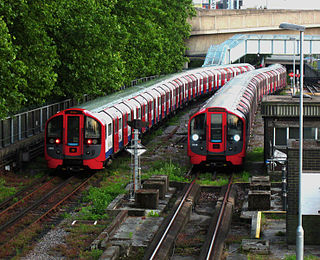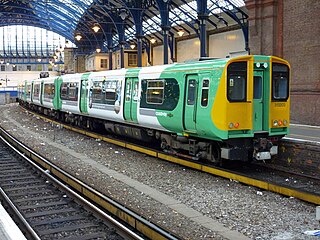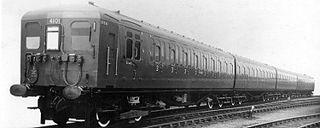
The Southern Railway (SR), sometimes shortened to 'Southern', was a British railway company established in the 1923 Grouping. It linked London with the Channel ports, South West England, South coast resorts and Kent. The railway was formed by the amalgamation of several smaller railway companies, the largest of which were the London and South Western Railway (LSWR), the London, Brighton and South Coast Railway (LB&SCR) and the South Eastern and Chatham Railway (SE&CR). The construction of what was to become the Southern Railway began in 1838 with the opening of the London and Southampton Railway, which was renamed the London & South Western Railway.

The Southern Railway (SR) gave the designations 4-COR, 4-RES, 4-BUF and 4-GRI to the different types of electric multiple unit built to work the route between London Waterloo and Portsmouth Harbour. The 4-COR type units survived long enough in British Rail ownership to be allocated TOPS Class 404. The COR designation had previously been used for the 6-PUL units and was reused by them during World War II when the Pullman car was stored, but this stock was different from the 4-COR units.

London Underground rolling stock includes the electric multiple-unit trains used on the London Underground. These come in two sizes, smaller deep-level tube trains and larger sub-surface trains of a similar size to those on British main lines, both running on standard gauge tracks. New trains are designed for the maximum number of standing passengers and for speed of access to the cars.
The Southern Railway (SR) gave the designations 6 PUL, 6 CITY and 6 PAN to electric multiple units built to work the routes between London and Brighton, West Worthing and Eastbourne. None of these units survived long enough in British Rail ownership to be allocated a TOPS class number. The 6 PUL units were designated 6 COR until 1935.

The Southern Railway (SR) gave the designation 2-BIL to the DC third rail electric multiple units built during the 1930s to work long-distance semi-fast services on the newly electrified lines from London to Eastbourne, Portsmouth and Reading. This type of unit survived long enough in British Rail ownership to be allocated TOPS Class 401.

The Southern Railway (SR) gave the designation 4-LAV to the electric multiple units built to work the semi-fast services on the route between London and Brighton. None of these units survived long enough in British Rail ownership to be allocated a TOPS class.
2-WIM was the designation given, by Southern Railway (SR), to a 4-strong fleet of electric multiple units, dedicated for use on the ex-LBSCR West Croydon to Wimbledon Line, using the headcode 2. None of these units survived long enough in British Rail ownership to be allocated a TOPS class.
The Southern Railway (SR) gave the designation 2-SL to the small fleet of electric multiple units dedicated for use on the South London lines. None of these units survived long enough in British Rail ownership to be allocated a TOPS class. In Southern Railway/Region days, they mainly spent their lives as 2-car units on the ex-LBSCR Wimbledon-West Croydon Line with head code 2. They were distinctive, because they retained their flat roofs over the driving cabs, where the pantographs were originally situated.
The Southern Railway (SR) gave the designation CW to the fleet of AC electric multiple units used on the lines to Coulsdon and Wallington. They were planned by the London, Brighton and South Coast Railway, but were delayed by World War I and the grouping and were introduced by the Southern Railway.
The Southern Railway (SR) gave the designation CP to the fleet of AC electric multiple units used on the former London, Brighton and South Coast Railway lines in the Crystal Palace area.

The British Rail Class 313 was a dual-voltage electric multiple unit (EMU) train built by British Rail Engineering Limited's Holgate Road carriage works between February 1976 and April 1977. They were the first production units that were derived from British Rail's 1971 prototype suburban EMU design which, as the BREL 1972 family, eventually encompassed 755 vehicles over five production classes. They were the first second-generation EMUs to be constructed for British Rail and the first British Rail units with both a pantograph for 25 kV 50 Hz AC overhead lines and contact shoe equipment for 750 V DC third rail supply. They were, additionally, the first units in Britain to employ multi-function automatic Tightlock couplers, which include electrical and pneumatic connections allowing the coupling and uncoupling of units to be performed unassisted by the driver whilst in the cab.

An electric multiple unit (EMU) is an electric self-powered train, capable of operating in multiple with other EMUs and without the need for a locomotive; these are typically passenger trains with accommodation in every vehicle and a driving position at each end. The term can also be used to describe a train that is a permanent formation with a non-driving power car, such as the Advanced Passenger Train. As of December 2010, two-thirds of the passenger carriages in Great Britain are formed in EMUs.

The British Rail Class 306 was a fleet of electric multiple unit (EMU) trains introduced in 1949. It consisted of 92 three-car trains which were used on the Great Eastern Main Line between Shenfield and London Liverpool Street.

An electric multiple unit or EMU is a multiple-unit train consisting of self-propelled carriages using electricity as the motive power. An EMU requires no separate locomotive, as electric traction motors are incorporated within one or a number of the carriages. An EMU is usually formed of two or more semi-permanently coupled carriages, but electrically powered single-unit railcars are also generally classed as EMUs. The great majority of EMUs are passenger trains, but versions also exist for carrying mail.

The British Rail Class 415 was a suburban 750 V DC third rail electric multiple unit commissioned by the Southern Region of British Railways. Built between 1951 and 1957, it became the most numerous class on the region after the withdrawal of the 4SUBs. The final trains were withdrawn in the 1990s, replaced by Class 455, 456, 465 and 466.

The British Rail Class 506 was a 3 carriage electric multiple unit (EMU) built for local services between Manchester, Glossop and Hadfield on the Woodhead Line, which was electrified in 1954 on the 1,500 V DC overhead system.

The Southern Railway (SR) and the British Railways used the designation Sub to cover a wide variety of electric multiple-unit passenger trains that were used on inner-suburban workings in the South London area. The designation 'Sub' was first officially used in 1941 to refer to newly built 4-car units. However, during the 1940s large numbers of earlier '3-Car Suburban Sets' were increased to four cars by the addition of an 'Augmentation' trailer, and became part of the 4-Sub category. The SR and BR (S) continued to build or else rebuild 4-car units to slightly different designs which became part of the 4-Sub Class. Many of these later examples survived in passenger use until late 1983, by which time British Rail had allocated to them TOPS Class 405.

Metropolitan Railway electric multiple units were used on London's Metropolitan Railway after the lines were electrified in the early 20th century.

The class 3SUB were DC suburban electric multiple units, introduced by the London and South Western Railway in 1915. They were constructed by the Southern Railway in the period up to 1939, and though the class designation 3SUB was not used by the Southern Railway, some authors refer to these units as 3SUB. When rebuilt to four cars in the 1940s, they became class 4SUB.

The electrification of the LSWR refers to the installation of electric traction on the London and South Western Railway surface network, and its successor the Western Section of the Southern Railway, in England. The LSWR started a programme of electrification in response to rising costs and loss of traffic to street tramways; the first installation was to Kingston, Richmond, Hounslow, Hampton Court and Shepperton, starting in 1917. The third rail DC system was used, as it was assessed to be considerably cheaper to install and maintain than the overhead systems then in use. The rolling stock was constructed by the conversion of relatively new coaches built for suburban steam-hauled operation. The LSWR generated its own electric power at a new power station near Wimbledon. A frequent regular-interval timetable was implemented and the system was a considerable success.















